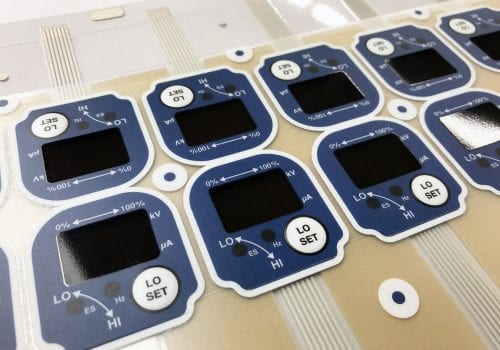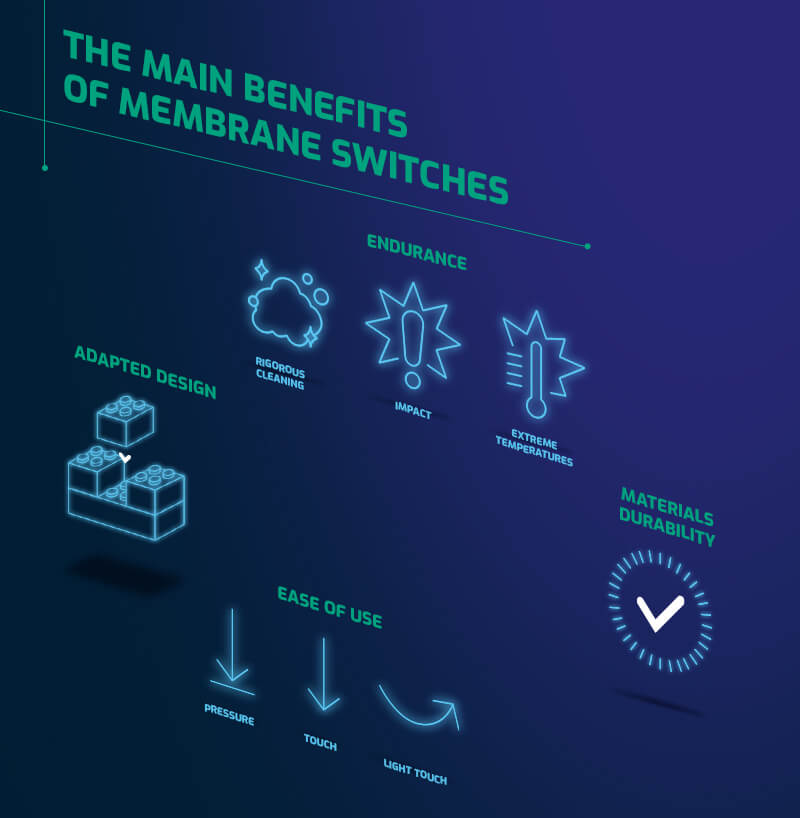Understanding the Significance of Membrane Switch Over in Modern Electronic Devices
Membrane switches are essential components in modern digital gadgets. They provide a blend of performance and layout that enhances individual interaction. Their lightweight and resilient nature makes them ideal for various applications. As sectors advance, the demand for personalization and advanced attributes expands. Recognizing exactly how membrane switches over add to development reveals their value fit the future of electronic devices. What lies in advance for this innovation?
The Basics of Membrane Change Technology
Frequently forgotten, membrane layer switch modern technology plays a necessary function in the modern-day electronics landscape. These gadgets, composed of numerous layers, act as customer interfaces for different electronic products, varying from household devices to medical tools. A common membrane layer switch contains a graphic overlay, a spacer layer, and a circuit layer, which are meticulously set up to develop a practical interface.When stress is put on the overlay, the circuit layer is completed, permitting signals to be sent to the device. This modern technology is known for its convenience, enabling personalization in style, capability, and form to fulfill particular individual demands. Additionally, membrane switches are lightweight and slim, making them suitable for applications where area is a costs. Their sturdiness and resistance to ecological aspects additionally improve their charm, guaranteeing they can withstand severe problems while keeping capability. On the whole, membrane layer button modern technology is essential to developing efficient and user-friendly electronic tools

Key Benefits of Membrane Switches
Membrane layer switches offer several essential benefits that make them a preferred option in different electronic applications. Their design enables for a small type element, enabling producers to create light-weight and streamlined gadgets. Additionally, membrane switches are immune to dust, moisture, and chemicals, which improves their durability and long life in demanding settings. The responsive feedback provided by these switches can enhance customer experience, making them easy and user-friendly to operate.Furthermore, membrane layer switches can be tailored with diverse graphics and colors, enabling one-of-a-kind branding chances. The manufacturing process is generally affordable, especially for high-volume manufacturing, as it decreases setting up time and streamlines design. Membrane layer changes require marginal upkeep, contributing to lower general functional expenses. These advantages underscore their growing appeal in contemporary electronics, where reliability and user-friendly user interfaces are necessary.

Applications Throughout Various Industries
The adaptability of membrane switches over enables their widespread adoption throughout different sectors. In the clinical area, they are generally used in diagnostic equipment and client tracking systems, providing a resilient interface immune to pollutants. The automotive sector utilizes membrane layer buttons for dashboard controls, boosting user experience with smooth styles that hold up against extreme conditions. In customer electronic devices, they work as control panels for devices such as microwaves and coffee makers, offering an easy to use user interface that is easy to clean. The aerospace sector utilizes membrane buttons in cabin controls, where dependability and space performance are paramount. Furthermore, the industrial field leverages these buttons in machinery and control systems to assure robust operation popular atmospheres. This wide series of applications emphasizes the adaptability of membrane buttons, making them indispensable components in enhancing capability and individual interaction across diverse technical landscapes.
Personalization and Style Flexibility

Future Trends in Membrane Switch Over Growth
Arising fads in membrane layer button growth show an expanding emphasis on improved capability and assimilation with clever innovations. As customer need for more innovative electronic tools rises, makers are concentrating on producing membrane layer switches that not just serve fundamental operational roles however also integrate attributes like touch level of sensitivity, backlighting, and check it out haptic feedback.Furthermore, innovations in products are expected to enhance toughness and ecological resistance, making membrane changes appropriate for diverse applications in industries such as health care, automotive, and consumer electronic devices. The integration of capacitive touch modern technology is most likely to come to be a lot more prevalent, enabling sleeker designs and improved individual interfaces. membrane switch.Additionally, the surge of the Internet of Points (IoT) is triggering the development of membrane layer switches that can connect wirelessly with other devices, boosting interconnectivity. On the whole, the future of membrane button innovation appears encouraging, driven by innovation and the pursuit of easy to use remedies
Frequently Asked Inquiries
Just How Do Membrane Layer Switches Contrast to Standard Mechanical Switches?
Membrane buttons, being extra space-efficient and using a sleek layout, contrast with standard mechanical buttons that offer tactile comments. The previous frequently include personalized graphics, while the latter commonly guarantee longevity and integrity in various applications.
What Products Are Typically Used in Membrane Change Manufacturing?
Membrane layer buttons are normally produced using materials such as polyester, polycarbonate, and published conductive inks. These products provide responsiveness, resilience, and versatility, making them appropriate for numerous applications in electronic gadgets and interface.
Can Membrane Switches Be Repaired or Recycled?
Membrane layer buttons can commonly be fixed, specifically if small problems occur, such as adhesive failing or surface area damage. However, complete reuse is normally restricted because of wear and possible deterioration of products in time.
How Do Environmental Factors Impact Membrane Switch Over Efficiency?
Environmental variables, such as moisture, temperature level, and direct exposure to chemicals, considerably influence membrane layer switch performance. Severe conditions can bring about deterioration, affecting responsiveness and long life, ultimately endangering the functionality of the tool in various applications.
What Is the Regular Life Expectancy of a Membrane Layer Switch?
The typical lifespan of a membrane button generally ranges from 1 to 5 million actuations, depending upon variables such as usage frequency, environmental problems, and the materials utilized in production, influencing toughness and performance durability. A regular membrane switch is composed of a visuals overlay, a spacer layer, and a circuit layer, which are carefully set up to produce a functional interface - membrane switch.When stress is used to the overlay, the circuit layer is completed, enabling signals to be transmitted to the gadget. The responsive responses offered by these switches can improve customer experience, making them easy and user-friendly to operate.Furthermore, membrane layer switches can be customized with diverse graphics and colors, enabling for special branding opportunities. As consumer demand for much more sophisticated digital tools rises, suppliers are concentrating on developing membrane changes that not just serve standard functional roles but likewise integrate attributes like touch level of sensitivity, backlighting, and haptic feedback.Furthermore, advancements in materials visite site are expected to enhance toughness and ecological resistance, making membrane switches ideal for diverse applications in industries such as health care, automobile, and consumer electronics. The integration of capacitive touch modern technology is most likely to come to be extra common, enabling for sleeker layouts and boosted customer interfaces.Additionally, the increase of the Internet of Points (IoT) is triggering the advancement of membrane switches over that can interact wirelessly with other tools, dig this improving interconnectivity. Membrane buttons, being a lot more space-efficient and offering a sleek layout, contrast with traditional mechanical buttons that provide tactile responses